I am involved with several long-running projects relating to landscape, settlement, and memory. In some cases they link interest in settlement with that of memory, including mortuary monuments. Of particular significance are the North Pembrokeshire Historical Archaeology Project, the use of furniture – especially the dresser – defining space and affecting lived experience, and the archaeology of Prisoner of War camps.
North Pembrokeshire Historical Archaeology Project
The North Pembrokeshire Historical Archaeology Project is a long-term research initiative investigating many aspects of archaeology relating to the period from the 17th century onwards. Much of the work to date has been on later 18th-, 19th- and 20th-century material, both settlements and graveyard memorials (see historic mortuary). More recent fieldwork was largely concentrated on excavations at Henllys Farm, a site which may reveal a sequence which runs back into at least the late Middle Ages.
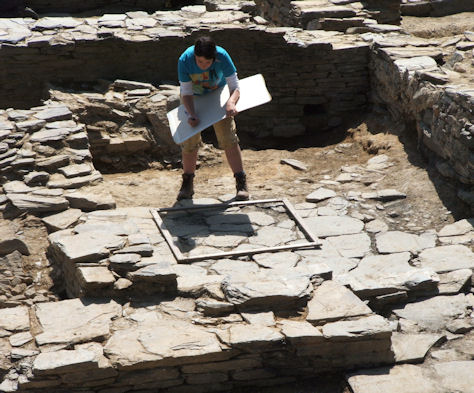
The purpose of the project is to investigate a rural community in a relatively isolated part of Britain with a strong Welsh cultural identity, and with significant subcultures based not only on socio-economic categories, but also on language and religion. This allows for analysis through settlement and artefact evidence and graveyard memorial data of the various ways in which identity was expressed through and by material culture.
Excavation and settlement survey has taken place intermittently during the 1980s and 1990s on abandoned cottages, farms and mills in the parishes of Eglwyswrw, Meline, Nevern and Newport, revealing from a total of 7 settlements a material culture belonging to the lower socio-economic classes in north Pembrokeshire of the period from the later 18th to early 20th century (Mytum 1988). Until 1998, no higher status settlements had been investigated, however, and no settlements of any type had been located for the 16th, 17th or earlier 18th centuries. The Henllys Farm site was investigated 1998 – 2008 and helps to fill some of these gaps.
The sites investigated have been as follows:
Berry Hill, Nevern (SN 068 401)
A small building originally designed as a summerhouse but later adapted into a small dwelling, was surveyed and investigated by limited excavation. The most notable features were two date stones carved out of small irregular boulders, and set into one wall of the summerhouse. This building was set at the southern edge of the gardens associated with Berry Hill House, one of the more substantial farms of the 18th and 19th century in the area (Mytum 1989).
Fron Haul, Newport (SN 073 381)
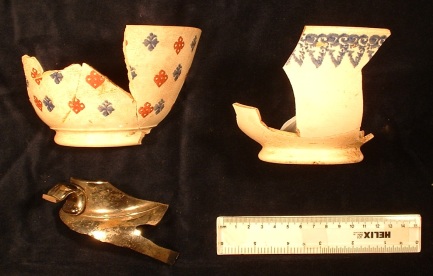
Small cottage on the western slopes of the Clydach valley. It had a small attached store and a pig-sty at a short distance. One room, used as a bedroom, had been added to the cottage. A small 19th- to early 20th-century midden was located on the boundary bank opposite the cottage and this was fully excavated.
Llystyn Mill, Nevern (SN 075 386)
A fulling mill complex was located, surveyed and partially excavated on the eastern side of the Clydach. A timber-framed mill was originally set on a small terrace, with the wheel placed in a stone-lined pit with a culvert leading to the Clydach. The leet ran along the eastern side of the valley in a substantial ditch, then turned to power the wheel. A stone cottage to the north was probably the domestic residence associated with the timber mill, of which no remains were found. A later fulling mill was built in stone slightly to the north, with the leet being extended and again turning to power a wheel in a pit. This was an overshot wheel, with the outflow through the wall of the mill almost directly into the Clydach. This water wheel powered the fulling stocks. In the same room were the bases of structures used for heating; their chimneys were built into the wall of the mill. An adjacent room, with piped water supply from the leet, also had bases for structures. These would have been vats for the washing or dyeing of the cloth. One vat had an outflow along a gutter which ran down the side of a paved roadway which led up the hill slope from the mill.
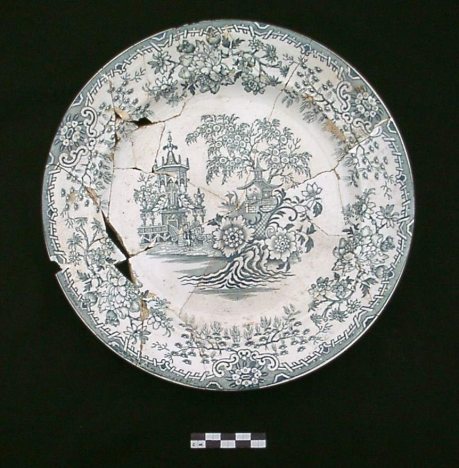
On the other side of the roadway was the original stone cottage. The west wall of this was demolished and a two-storey house was constructed in the same finish of masonry as that used for the mill. A pig-sty lay up the hill above the room adjacent to the mill. Excavations revealed many of the internal features and an assemblage of mainly 19th-century artefacts, though no midden was found.
Pant-teg, Eglwyswrw (SN 123 394)
A farm house was surveyed and small scale excavations conducted in its yard. The farm consisted of a two-storey house with attached store, a detached range of agricultural buildings including a stable, and a cart house. Behind the cart house and adjacent to a pig-sty a midden was located and excavated; this was mainly consisted of 19th-century material, with some from the early 20th century. The midden overlay an agricultural structure made of drystone walling that may have been for storage.
Parcau, Newport (SN 073 387)
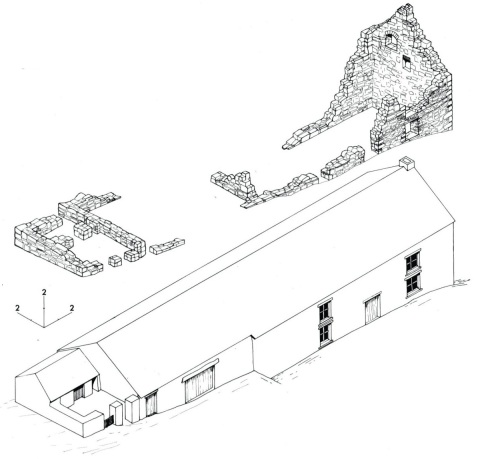
Two-storey cottage with outbuilding, pig sty and yard. A substantial midden was sampled which had built up against a boundary bank of the yard, which was mainly of 19th-century date. Excavations within the cottage revealed a small sub-surface store.
On the opposite side of the trackway which gave access to the cottage was a second cottage and a small outbuilding, not illustrated here.
Penpedwast, Meline (SN 122 389)
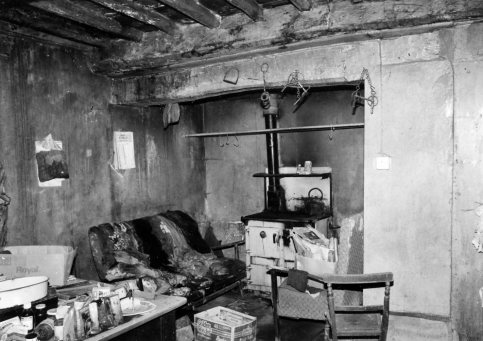
The farm complex was planned, and a photographic survey of the house (since restored) revealed many interior features of interest.
Trial excavation conducted in the field to the south-east revealed 18th-century bottle dumps and later land drains.
Some 17th-century and later pottery was recovered from hillwash deposits suggesting refuse from the farm. The ceramics have been published (Mytum and Grundy 1985).
Pwll Mill (SN 074 388)
Small corn mill set on the opposite bank of the Clydach to Pwll farmhouse. The mill had an overshot wheel, powered by water diverted off the Clydach along a leet which ran along the eastern side of the valley. A separate cottage was positioned at right angles to the mill. No midden was found, but excavations in the mill and cottage defined internal features and led to the recovery of a finds assemblage of the 18th and 19th century.
Henllys Farm (SN 109 393)
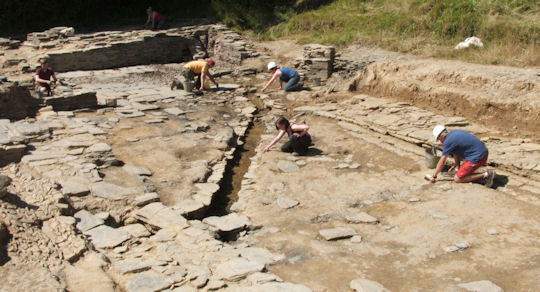
The residence of George Owen, a distinguished 16th-century antiquary, was demolished in the 19th century and a farmhouse placed nearby (Charles 1948, 1973, Miles 1994). Survey and trial excavation and survey located the site of the original house and subsequent seasons have revealed the whole plan.

The more recent history of the site, and the experience of the Harries family – the last tenants – has been published in Mytum 2010. The last years of the farm were, according to the limited documentary sources, ones of managed decline, and this was clearly demonstrated in the archaeology, with walls propped up in various places.
Some family members have memorials identified in our graveyard survey of Nevern churchyard.
Conclusions
The long-term North Pembrokeshire Historical Archaeology Project uniquely combines settlement survey, excavation and graveyard recording at a regional scale. The results provide information on lifeways and deathways which can be compared and correlated with historical and ethnographic data for the wider region. It has been possible to define the material culture correlates of social, economic, cultural and religious identities. Moreover, the ways in which material culture was actively used to negotiate these identities by the 18th- and 19th-century inhabitants of this region of Britain is now being considered.
Evidence for agricultural and industrial production has been investigated, and the role of ceramics and gravestone monuments is being studied in greater detail at the moment. Some of the ceramics from these sites were undoubtedly displayed on dressers in these homes, and provided one of inspirations for the archaeology of furniture topic discussed below.
REFERENCES
Charles, B.G. (1948) ‘The Second Book of George Owen’s Description of Penbrokeshire‘, National Library of Wales Journal, 5
Charles, B. G. (1973) George Owen of Henllys: A Welsh Elizabethan. Aberystwyth: National Library of Wales.Miles, D. ed. (1994) The Description of Pembrokeshire. George Owen of Henllys. Llandysul: Gomer Press.
Mytum, H. (1988) ‘The Clydach Valley. A 19th Century Landscape’, Archaeology Today 9.3, 33-37.
Mytum, H. (1989) ‘An Eighteenth Century Summerhouse at Berry Hill, Nevern, Dyfed’, Bulletin of the Board of Celtic Studies 36, 263-267.
Mytum, H. (2010) ‘Biographies of projects, people and places: Archaeologists and William and Martha Harries at Henllys Farm, Pembrokeshire’, Post-Medieval Archaeology, 44(2), 294-319.
The archaeology of furniture and the dresser
The dresser
The archaeology of Prisoner of War camps – Knockaloe and Douglas, Isle of Man in World War 1
Knockaloe
